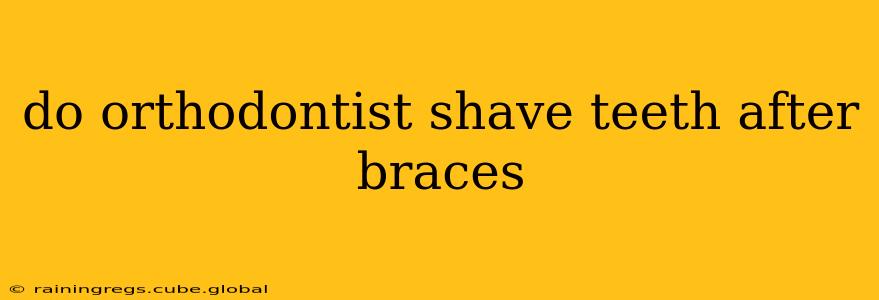The question of whether orthodontists "shave" teeth after braces is a common one, often stemming from misconceptions about the process of removing bonded brackets and cleaning teeth post-treatment. The short answer is no, orthodontists don't shave teeth in the traditional sense. However, the process of removing braces does involve some reshaping and smoothing of the tooth surface. Let's delve deeper into the specifics.
What Happens During Brace Removal?
When braces are removed, the orthodontist uses special pliers to carefully detach each individual bracket from the tooth. This process doesn't involve shaving or grinding away significant portions of enamel. Instead, it's a precise removal that focuses on separating the bracket from the adhesive that bonded it to the tooth.
After bracket removal, a small amount of adhesive residue might remain on the tooth's surface. This is where the misconception of "shaving" might arise. To ensure a smooth, clean finish and to remove any remaining adhesive, the orthodontist will use a specialized instrument, often a fine-grit polishing wheel or a small abrasive instrument. This polishing process removes the minimal adhesive residue, leaving the tooth's surface smooth.
Is Enamel Removed During Polishing?
Yes, a minuscule amount of enamel may be removed during the polishing process. However, the amount is incredibly small, far less than the natural wear and tear your teeth experience from everyday activities like chewing. Think of it as a very fine sanding, rather than a significant shaving or grinding. This minimal enamel removal is necessary to achieve a smooth, comfortable surface and prevent any potential irritation from the remaining adhesive.
What if My Teeth Feel Rough After Brace Removal?
If your teeth feel rough after brace removal, don't be alarmed. This is often temporary and can be due to several factors:
- Remaining Adhesive: Even with careful polishing, tiny amounts of adhesive might persist. This typically wears away naturally within a few days.
- Debris: Food particles or plaque can accumulate more easily on the slightly textured surface, leading to a rough feeling. Thorough brushing and flossing will resolve this.
- Irritation: The gums may be slightly irritated from the brace removal process, contributing to a sensitivity or rough feeling. This too is typically temporary.
If the roughness persists for more than a week or is accompanied by significant discomfort, consult your orthodontist.
Will My Teeth Be Permanently Damaged?
No, the minimal enamel removal during brace removal will not permanently damage your teeth. The amount of enamel removed is insignificant compared to the overall enamel structure of your teeth. The procedure is safe and routine, with millions of people undergoing it each year without long-term issues.
Do I Need Any Special Aftercare?
Post-brace removal, good oral hygiene is essential. This includes:
- Brushing twice daily: Use a fluoride toothpaste and a soft-bristled toothbrush.
- Flossing daily: This helps remove plaque and food particles from between your teeth.
- Using a fluoride mouthwash: This strengthens the enamel and reduces the risk of cavities.
- Regular dental checkups: Schedule routine checkups with your dentist and orthodontist for monitoring and cleaning.
What About Whitening After Braces?
Many patients consider teeth whitening after their braces are removed. This is perfectly safe and can help achieve a brighter, more even smile. Discuss your whitening options with your orthodontist or dentist to determine the best approach for your individual needs.
By understanding the process of brace removal and aftercare, you can feel confident that the minimal enamel removal during polishing is a necessary and safe part of achieving a healthy, beautiful smile. Remember, maintaining good oral hygiene is crucial for long-term oral health.
